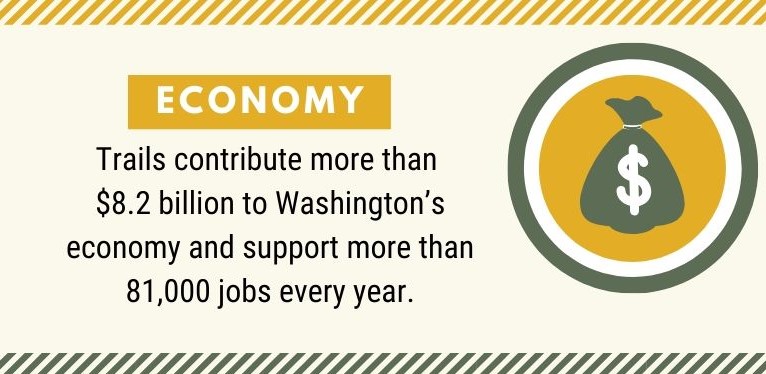Economic and Health Benefits of Walking, Hiking, and Bicycling on Recreational Trails in Washington State
These two companion studies look at the economic, environmental, social, and health benefits of trails.
Trail Use Happens Statewide
Every county in Washington State benefits from walkers, runners, bikers, and backpackers using our beautiful trail systems. Ninety percent of Washington residents participate in non-motorized recreation annually.
Economic Benefits
Economic Benefits of Trails by County


Heath Benefits
Trail-based activities offer many health benefits including improved cholesterol levels and protection against chronic diseases like cardiovascular disease, diabetes, and obesity.
Outdoor exercise also can improve mood, restore attention, and decrease anger, depression, and stress. This is critical because Washington reports higher levels of adults suffering from some form of depression or mental illness and children reporting more major depressive episodes each year than the national average.
Children may particularly benefit from physical activity in nature because it is more conducive to social play, emotional development, and improved cognitive function than indoor activity.

Environmental Benefits
If that weren’t enough, trails offer environmental benefits too. Trails have a lasting impact by preserving natural spaces from other uses like deforestation and development, and by protecting ecological systems vital to the health of Washington’s wild places that make this state such an amazing place to live and work. Trails typically provide protected corridors of natural space that are invaluable resources for environmental benefits like carbon sequestration, air filtration, and wildlife habitat.

Recommendations
- Encourage Development of New Trails and Improve Quality of Existing Trails
Build new trails and trailheads in areas where there is high use of other trails or a scarcity of trails. Maintain and improve the quality of trails to improve the experience of the user and therefore be a source of high value and benefits.
- Develop Standard Permitting Requirements Statewide
Requirements for building trails varies across the state. A statewide permitting process and set of clear trail language definitions would make it easier to build new trails.
- Conduct Comprehensive Planning for Trails
Long-term, statewide trail planning, similar to what is done for roads, could help address congestion and areas of future population growth to maximize the future benefits of trails.
- Encourage Development of Trails that Promote Multi-Day Trips
Money spent on overnight trips is significantly higher than on day trips. Therefore connecting existing trails and allowing for more camping would increase the economic benefits to local communities.
- Encourage Visitation by Adding New and Improving Existing Amenities
Amenities like maps, bathrooms, ample parking, water fountains, and views improve the quality of trails and in turn increase visitation. A plan to address scarcity of amenities is needed.
- Use Trails as a Health Intervention Strategy
Increased access to trails for populations vulnerable to health issues could have a major impact on overall health and could include public transportation to trails and subsidizing trail fees.
- Improve Data Collection of Trail Usage and Create Consistency
Participant use and economic benefit analysis is limited by the quantity and quality of data available. Therefore increasing survey samples and improving existing surveys is recommended.
Study Background
The Legislature approved funding for this project in the 2018 supplemental operating budget. The two reports were developed by ECONorthwest and the University of Washington.
The economic and health savings data was calculated using a combination of survey, on-site counts, economic models and third-party research. While there have been several studies that assess trail use in Washington, this is one of the first, substantial undertakings to better understanding the economic, health savings, and environmental benefits of trails.